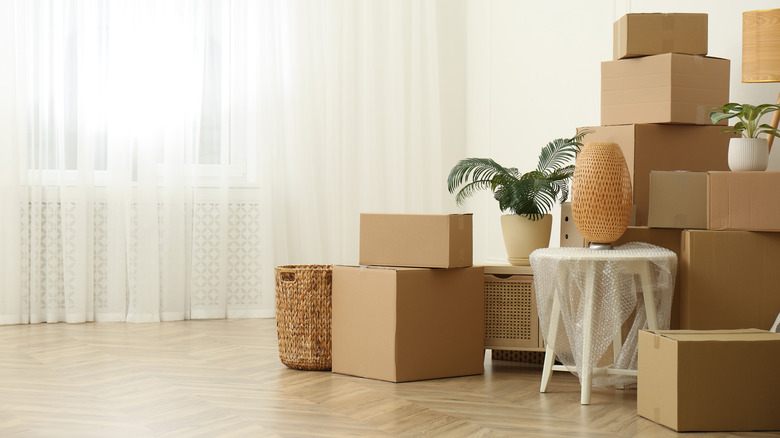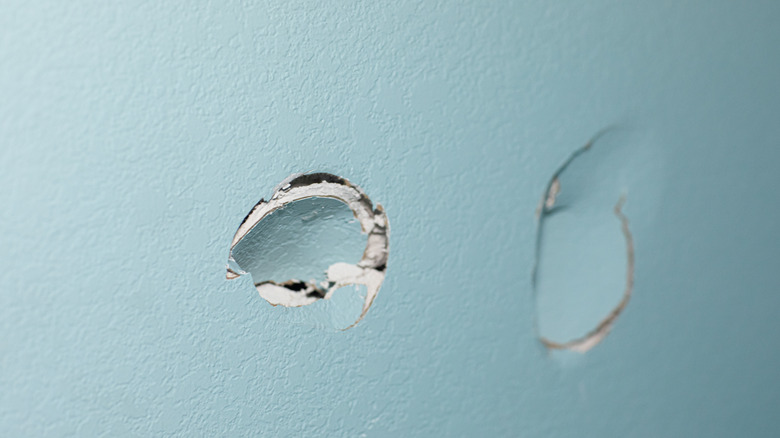What Is A Renter Generally Required To Fix Before Moving Out?
Maintaining a comfortable home is high on the list of priorities for anyone. For renters, however, the demands of home maintenance and cleaning routines take on a different sort of meaning. Renters are responsible for taking care of their living space, just like anyone else, but encounter an additional burden when it comes time to move out. A homeowner can pick and choose upgrade projects and repairs, but a renter can be forced to return a property to its original state at the end of a tenancy.
Zumper notes that landlords can't impose certain costs on a tenant, like those surrounding a new coat of paint on the walls. However, as a tenant, you shouldn't make permanent alterations to the walls or any other part of the home, and certainly not without asking your landlord first. Any changes you do make to the property may fall to you to fix or restore, so approaching personalization in a rented home requires great care.
Excessively damaged walls, floors, windows, and other fixtures
Standard deductions that tenants will see come off their deposit are for fixes to walls, windows, floors, and other parts of the home that go beyond wear and tear. The paint on your walls will dull with time, and this isn't something that a landlord can charge you for. However, if you've punched a series of holes in the wall, you'd better believe that your landlord will be asking for compensation!
Damage and breakages occur as a result of typical use on a regular basis. For example, after years of service, your dryer might break down. This is unavoidable and generally falls to the landlord to replace or repair. Conversely, if you stuff a bag of quarters in the dryer and destroy the drum, the repair falls to you. The same can be said of nearly any other fixture in the home. Overt damage caused by a renter (either intentional or accidental) falls to that tenant to fix. It may be a good idea to quote a few prices before you plan to move out so that you have a ballpark understanding of the cost. Burnt or excessively scratched flooring, chipped countertops, and stained furniture are all damages that a tenant will typically have to resolve, according to Realtor.com.
Pet damages and damage from tenant installations in the property
Two other categories of repair that a tenant is required to resolve are damage related to pets and returning any alterations to their original conditions. Some people may love art and want to introduce their own mural on the bedroom wall. This is a substantial change to the property and will need to be painted over. Similarly, adding shelves screwed into the walls will require the holes to be filled in.
Replacing tarnished furniture, flooring, or other features in the home that dogs or cats have ruined is also a necessity. Pets may chew on banisters, scratch doors, or relieve themselves on the couch or carpet. These damages fall squarely on the renter. If you have pets, taking steps to prevent them from damaging the home is crucial. Using a couch cover, putting up barriers to parts of the home, or taking training seriously can help reduce your out-of-pocket expenses upon any decision to move.
A renter can engage in these repairs themselves or leave the work to their landlord and then foot the bill. However, Apartments.com notes that any repairs you conduct on your own may require a second pass by a professional. This means you may spend time fixing the problem only to be forced to pay for another fix down the road. Caution is the best option in these situations.
A move in checklist or inventory makes these discrepancies crystal clear
The security deposit is designed to protect the financial health of both a tenant and landlord. Tenants pay this money to an escrow account (or the landlord directly), and it's held as a buffer for both individuals in the event that repairs are required later on. The security deposit gives landlords easy access to funds to make necessary repairs, and it prevents tenants from having to pay out of pocket. But the security deposit isn't the only thing that should be agreed upon when moving into a new apartment.
In addition to the funding, tenants should be given a check-in report that documents any defects or damages in the home. No property is ever perfect, so there will certainly be some issues to note. Documenting them might be a painstaking process, but taking the time at the start makes the move out much smoother.
A check-in report can be handled in a number of ways. Some landlords will hire an external inspector to comb through the property others might conduct a walkthrough with the tenant to document problem areas together. Redfin notes that tenants should be thorough when filling out a move-in checklist or evaluating one written for them. This document is the necessary evidence that will resolve potential disputes later on and should be taken extremely seriously.




